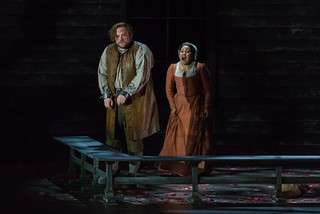|
Back
Powerful and perplexing Albany
Cooperstown (Alice Busch Theater)
07/23/2016 - & July 31, August 2, 5*, 8, 14, 18, 27, 2016
Robert Ward: The Crucible
Brian Mulligan (John Proctor), Jamie Barton (Elizabeth Proctor), Ariana Wehr (Abigail Williams), David Pittsinger (Reverend John Hale), Jay Hunter Morris (Judge Danforth), Zoie Reams (Tituba), Frederick Ballentine (Reverend Samuel Parris), Michael Miller (Thomas Putnam), Gabriella Sam (Ann Putnam), Helena Brown (Rebecca Nurse), Chaz'men Williams-Ali (Giles Corey), Zachary Owen (Francis Nurse), Mary Beth Nelson (Betty Parris), Maren Weinberger (Mary Warren), Ian Koziara (Ezekial Cheever), Emma Grimsley (Ruth Putnam), Molly Jane Hill (Susanna Walcott), Meroë Khalia Adeeb (Sarah Good)
The Glimmerglass Festival Orchestra, Nicole Paiement (conductor)
Francesca Zambello (director), Neil Patel (set designer), Jessica Jahn (costume designer), Mark McCullough (lighting designer), Eric Sean Fogel (choreographer)

B. Mulligan & A. Wehr (© Karli Cadel)
This year’s American opera at Glimmerglass is Robert Ward’s The Crucible. Its libretto, by Bernard Stambler, closely follows Arthur Miller’s four-act play inspired by the trials for witchcraft in Salem, Massachusetts in 1692-93.
The work was one of 11 operas commissioned by the New York City Opera thanks to a grant from the Ford Foundation. It premiered in 1961 and, unlike so many new works that have vanished after an initial run, it has been considered a relative success. NYCO performed it five times in 1961 and 1962, and a further four times in 1968 after the company had moved to Lincoln Center. The 1968 production also played for one performance at the San Francisco Opera.
While the play has become a modern stand-by, the opera has received only a smattering of productions. A recording was made of the initial cast and of a production at Indiana University in the 1980s. This nine-performance run at Glimmerglass is probably the longest it has ever received, albeit in a venue smaller than the “full size” theatres it was intended for. The festival’s intimacy has wonderful benefits.
The original NYCO production featured some of the strongest singers on their roster and this production also has an impressive cast. Brian Mulligan could not possibly be bettered as the conflicted central figure, John Proctor. He is matched by the fast-rising star, Jamie Barton, as his wife, Elizabeth.
Thirteen of the 17-member cast are members of the festival’s Young Artists Program. Outstanding among them is Ariana Wehr as Abigail Williams, the vengeful former servant and lover of John Proctor, who ensnares him in the town’s hysteria and resulting legal proceedings. Also notable is Helena Brown as Rebecca Nurse, a character who is also victimized despite her outspoken (and rare) common sense.
A degree of confusion arises from casting decisions. The suspicions of witchcraft arise from the activities of a slave woman (from Barbados) with a group of impressionable Salem girls. Her name is Tituba, ably performed by an African-American singer, Zoie Reams. Another slave, Sarah Good, is performed by Meroë Khalia Adeeb, also African-American. But at the same time there is colour-blind casting for other roles which gives the erroneous impression of a community populated by mixed-race couples. In other ways the play (and thus the opera) does not stick to historical fact; of necessity it must simplify the tortuous and perverse legal procedures. The end result is that the audience has quite a lot of work to do in sorting out the characters and the dramatic threads.
David Pittsinger gives a staunch performance as the Reverend John Hale, the man who investigates the charges of sorcery and later regrets the resulting damage. The real villain of the work, Judge Danforth who presides and persecutes at the witch trial, does not appear until Act III. Jay Hunter Morris’s high-octane delivery heightens the frenzied atmosphere to an almost unbearable degree.
Robert Ward’s music is the very expression of the roiling plot. The first act introduces us to no fewer than 10 characters who give a full, vivid picture of the shrill factionalism within the Salem community as rumours of witchcraft spread.
In Act II the focus switches to a familiar domestic situation as John Proctor is confronted by his unhappy wife. It turns out that he has had an affair with the dismissed servant; he is remorseful, but as the couple become embroiled in the witch hunt their reconciliation is overwhelmed by his principled refusal to sign a confession. This occurs in Act IV, following the prosecutorial trial and scenes of mass hysteria. In the end, the spectator feels both confused and tumbled-about, but not really enlightened.
This opera manages to be impressive without being convincing, despite Francesca Zambello’s intense focus on the drama in each scene. Neil Patel’s spartan sets and Mark McCullough’s moody lighting combine to heighten the dramatic effect. The musical leadership of Nicole Paiement, artistic director of San Francisco’s venturesome Opera Parallèle, holds the massive piece together.
The festival’s American opera for 2017 will be Gershwin’s Porgy and Bess.
Michael Johnson
|